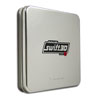Swift 3D 4

The little 3D vector-graphics animation tool that could
 With the addition of more advanced 3D modeling functions, Swift 3D remains an excellent value in the 3D software arena.
With the addition of more advanced 3D modeling functions, Swift 3D remains an excellent value in the 3D software arena.
Flash has more than proved itself as one of the key programs used to power the Internet and remains the designers’ choice for its ability to handle vectors, bitmaps, audio, and video for the Web. Yet despite its unbelievable scripting and illustration strengths, its 3D capabilities remain one of its weaknesses. This is where Electric Rain steps in with its fourth incarnation of Swift 3D.
While there are many new features in version 4, the secret to the success of Swift 3D remains in the ability to take 3D objects and animations and output them as high-quality SWF, AI/EPS, and SVG formats. While unchanged for this release, the RAViX III rendering engine is what makes all of this possible by taking both the scene’s lighting and geometry into account when re-creating the scene as vector-based frames. Dealing with file size and output quality is always a task we all dread, but with varying fill options that range from averaged color through linear gradients for each polygon, that worry no longer exists. And the ability to export advanced features (shadows, reflections, transparency, and highlights) as separate layers into Flash makes Swift 3D’s integration and workflow remarkable.
The area in Swift 3D that has seen the most improvement in version 4 is the modeling section. The existing Extrusion Editor and Lathe Editor have both been given minor adjustments, but the biggest change is the addition of an entirely new editing tool: the Advanced Modeler. This presents an existing object as an editable polygonal mesh. Selected vertices, edges, or faces can then be transformed using a combination of the interactive Move, Scale, Rotate, and Extrude tools, along with commands for aligning, mirroring, flattening, welding, and subdividing.
Particularly powerful are the soft selection capability and the ability to smooth and round surfaces—both important for creating more organic and natural shapes. As well as controlling the form of your objects, the Advanced Modeler allows you to define a surface group, setting whether lines should be rendered in that area or not. You can also apply separate materials and bitmaps to these groups—for example, to produce a cube with different-colored faces. And when applying bitmaps, you can use the Move, Scale, and Rotate tools to precisely control your texture mapping. Swift 3D 4’s bitmap handling is better all around and now includes support for importing textured 3DS files, as well as textured display in the viewports.
With modeling and formatting completed, it’s time to bring your scene to life. Again, the presets available in Swift 3D 4’s Gallery have been enhanced, providing a selection of professionally designed lighting schemes and fly-by, deformation, and path-based animations to place onto your model. New categories that have been added include high-quality models, common 2D shapes for extruding and lathing, and the five most common bevel types. You also now have the ability to save your models, shapes, animations, materials, and lights directly to the Gallery for future use. For more animation control, you can also now animate objects along a custom Bézier path and easily set a camera to follow the object.
Overall, Swift 3D 4 is a great 3D program for beginners or anyone wanting to bring 3D to Flash without the huge expense of buying a high-end 3D program.
PRICE: $189 (upgrade $99)
FOR: X
FROM: Electric Rain, Inc.
PHONE: 888-613-1500
WEB: www.erain.com
RATING: 5.0
